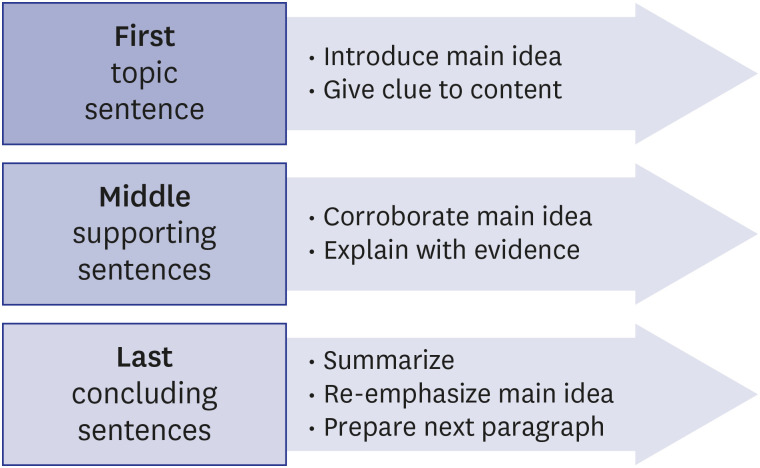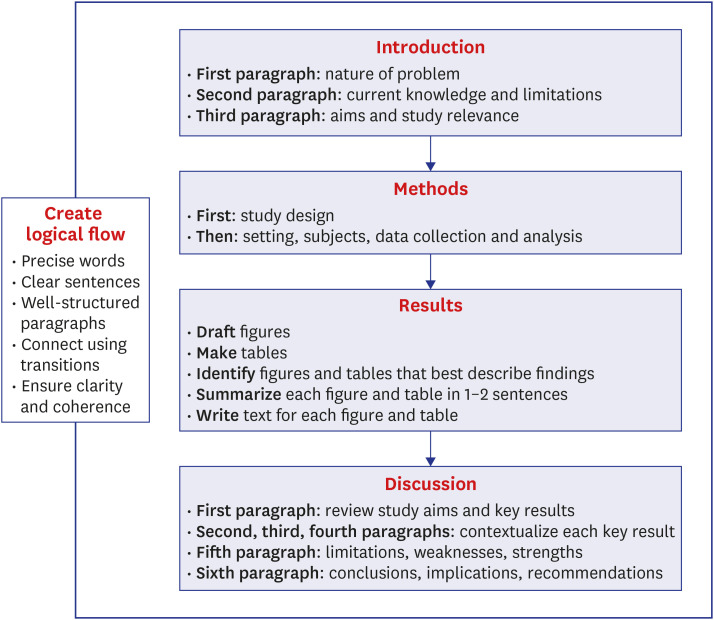J Korean Med Sci.
2021 Oct;36(40):e275. 10.3346/jkms.2021.36.e275.
Creating Logical Flow When Writing Scientific Articles
- Affiliations
-
- 1Department of General Education, Graduate School of Nursing Science, St. Luke's International University, Tokyo, Japan
- 2Department of Biological Sciences, Messiah University, Mechanicsburg, PA, USA
- KMID: 2521429
- DOI: http://doi.org/10.3346/jkms.2021.36.e275
Abstract
- Numerous guidelines on how to write a scientific article have been published. Many books and articles giving detailed instructions on how to develop a research question, perform a literature search, or design a study protocol are widely available. However, there are few guidelines on how to create logical flow when writing a scientific article. Logical flow is the key to achieving a smooth and orderly progression of ideas, sentences, paragraphs, and content towards a convincing conclusion. This article provides guidelines for creating logical flow when writing the text and main sections of a scientific article. The first step is creating a draft outline of the whole article. Once completed, the draft outline is developed into a single, coherent article that logically explains the study. Logical flow in the text is created by using precise and concise words, composing clear sentences, and connecting well-structured paragraphs. The use of transitions connects sentences and paragraphs, ensuring clarity and coherence when presenting academic arguments and conclusions. Logical flow in the main sections of a scientific article is achieved by presenting the whole story of the article sequentially in the introduction, methods, results, and discussion, focusing attention on the most important points in each section, and connecting all of these to the main purpose of the study.
Figure
Reference
-
1. Rabinowitz H, Vogel S. The Manual of Scientific Style: a Guide for Authors, Editors, and Researchers. Burlington, MA, USA: Elsevier/Academic Press;2009.2. Barroga EF. Essential modules for teaching publication writers. Med Writ. 2013; 22(1):4–9.
Article3. Mclndoo T. 5 Flow part 5: vary sentence structure. Updated 2016. Accessed August 11, 2021. https://waldenwritingcenter.blogspot.com/2016/07/5-flow-part-5-vary-sentence-structure.html.4. Kauchak D, Leroy G, Pei M, Colina S. Predicting transition words between sentence for English and Spanish medical text. AMIA Annu Symp Proc. 2020; 2019:523–531. PMID: 32308846.5. Iskander JK, Wolicki SB, Leeb RT, Siegel PZ. Successful scientific writing and publishing: a step-by-step approach. Prev Chronic Dis. 2018; 15:E79. PMID: 29908052.
Article6. Lowe J. The four levels of flow in writing: what it means when writing flows. Updated 2018. Accessed August 11, 2021. https://www.grammarflip.com/blog/the-four-levels-of-flow-in-writing-what-it-means-when-writing-flows.7. Forero DA, Lopez-Leon S, Perry G. A brief guide to the science and art of writing manuscripts in biomedicine. J Transl Med. 2020; 18(1):425. PMID: 33167977.
Article8. Christiansen S, Iverson C, Flanagin A, Livingston EH, Fischer L, Manno C, et al. AMA Manual of Style: a Guide for Authors and Editors. 11th ed. Oxford, UK: Oxford University Press;2020.9. Gasparyan AY, Ayvazyan L, Blackmore H, Kitas GD. Writing a narrative biomedical review: considerations for authors, peer reviewers, and editors. Rheumatol Int. 2011; 31(11):1409–1417. PMID: 21800117.
Article10. International Committee of Medical Journal Editors. Recommendations for the conduct, reporting, editing, and publication of scholarly works in medical journals. Updated 2019. Accessed September 2, 2021. http://www.icmje.org/news-and-editorials/updated_recommendations_dec2019.html.11. Balch CM, McMasters KM, Klimberg VS, Pawlik TM, Posner MC, Roh M, et al. Steps to getting your manuscript published in a high-quality medical journal. Ann Surg Oncol. 2018; 25(4):850–855.
Article12. Moxley JM, Paquette J. Flow, coherence, unity. Updated 2019. Accessed August 11, 2021. https://writingcommons.org/section/style/flow-coherence-unity/.13. Steady like a river: organizing your articles for “smooth and logical flow”. Updated 2015. Accessed August 12, 2021. http://blog.writersdomain.net/steady-like-a-river-organizing-your-articles-for-smooth-and-logical-flow/.14. Create perfect logical flow in your writing. Updated 2018. Accessed August 10, 2021. https://www.writerscollegeblog.com/create-perfect-logical-flow-in-your-writing/.15. How do you write logically. Accessed August 10, 2021. https://owl.purdue.edu/owl/general_writing/academic_writing/logic_in_argumentative_writing/logic_in_writing.html.16. What are the 5 types of paragraphs. Accessed August 11, 2021. https://sites.google.com/site/basicslanguagearts/home/components-of-a-paragraph/different-type-of-paragraphs.17. How do you write a logical flow in writing. Updated 2013. Accessed August 11, 2021. https://waldenwritingcenter.blogspot.com/2013/12/five-ways-to-create-flow-in-your-writing.html.18. Kachgal T. 5 Flow part 4: develop a clear, concise style. Updated 2016. Accessed August 11, 2021. https://waldenwritingcenter.blogspot.com/2016/07/5-flow-part-4-develop-clear-concise.html.19. Yakhontova T. Conventions of English research discourse and the writing of non-Anglophone authors. J Korean Med Sci. 2020; 35(40):e331. PMID: 33075853.
Article20. How do you write a flow sentence. Accessed August 11, 2021. https://writingcenter.uagc.edu/making-your-writing-flow.21. Paragraphs, flow and connectivity. Accessed August 11, 2021. https://www.sheffield.ac.uk/ssid/301/study-skills/writing/academic-writing/paragraph-flow-connectivity.22. Henville L. Making paragraphs flow. Updated 2018. Accessed August 17, 2021. https://shortishard.com/2018/05/12/making-paragraphs-flow/.23. Arora J. How to create a logical flow in your academic writing. Updated 2020. Accessed August 17, 2021. https://webinvantive.com/how-to-create-a-logical-flow-in-your-academic-writing/.24. Davis B. What is logical writing? Updated 2021. Accessed August 17, 2021. https://www.mvorganizing.org/what-is-logical-writing-2/.25. Strategies for enhancing 'flow' in your academic writing: 5 part blog series. Updated 2016. Accessed August 10, 2021. https://waldenwritingcenter.blogspot.com/2016/06/strategies-for-enhancing-flow-in-your.html.26. Licciardi A. Making connections: logical flow in scientific writing. Updated 2020. Accessed August 11, 2021. https://www.letpub.com/Logical-Flow-in-Scientific-Writing.27. What is logical in technical writing. Updated 2020. Accessed August 10, 2021. https://medium.com/level-up-web/logic-errors-in-technical-writing-b0ff8e948e3d.28. How to create perfect logical flow in your writing. Updated 2021. Accessed August 12, 2021. https://siboloaded.com/logical-flow/.29. Yakhontova T. What nonnative authors should know when writing research articles in English. J Korean Med Sci. 2021; 36(35):e237. PMID: 34490755.
Article30. Coghill AM, Garson LR. The ACS Style Guide: Effective Communication of Scientific Information. 3rd ed. Washington, D.C., USA: American Chemical Society;2006.31. Valenti WC. Toward a good scientific writing. Int Aquatic Research. 2014; 6(4):175–176.
Article32. Bushman FD. Improving your scientific writing: a short guide. Updated 2019. Accessed August 15, 2021. https://www.fresheyesediting.com/2019/02/07/top-3-online-resources-to-improve-your-scientific-writing/.33. Yakhontova T. Paragraphing in English articles: tips for non-Anglophone authors. J Korean Med Sci. 2021; 36(10):e62. PMID: 33724735.
Article34. Lunning L. 5 Flow part 1: create logical connections for flow in your writing. Updated 2016. Accessed August 11, 2021. https://waldenwritingcenter.blogspot.com/2016/06/clearing-path-logical-connections-and.html.35. Considine BK. 5 Flow part 2: use topic sentences so your prose flows. Updated 2016. Accessed August 11, 2021. https://waldenwritingcenter.blogspot.com/2016/07/5-flow-part-2-use-topic-sentences-so.html.36. How can a writer achieve a good paragraph. Updated 2021. Accessed August 11, 2021. https://www.masterclass.com/articles/how-to-write-a-perfect-paragraph.37. Philbrook M. 5 Flow part 3: transition with words, sentences, and paragraphs. Updated 2016. Accessed August 11, 2021. https://waldenwritingcenter.blogspot.com/2016/07/5-flow-part-3-transition-with-words.html.38. Effective transitions in research manuscripts. Accessed August 12, 2021. https://www.aje.com/arc/editing-tip-effective-transitions/.39. Tuten N. Using transitions to improve clarity and logical flow. Updated 2020. Accessed August 12, 2021. https://getitwriteonline.com/coherence-transition-words/.40. Jawhara S. How to boost the immune defence prior to respiratory virus infections with the special focus on coronavirus infections. Gut Pathog. 2020; 12(1):47. PMID: 33062058.
Article41. Diener E, Oishi S, Tay L. Advances in subjective well-being research. Nat Hum Behav. 2018; 2(4):253–260. PMID: 30936533.
Article42. Speakman JR. Obesity and thermoregulation. Handb Clin Neurol. 2018; 156:431–443. PMID: 30454605.
Article43. Stanhope J, Weinstein P. Learning from COVID-19 to improve access to physiotherapy. Aust J Prim Health. 2020; 26(4):271–272. PMID: 32669194.
Article44. Hosonaga M, Arima Y, Sampetrean O, Komura D, Koya I, Sasaki T, et al. HER2 heterogeneity is associated with poor survival in HER2-positive breast cancer. Int J Mol Sci. 2018; 19(8):2158.
Article45. Iida Y, Ito T, Kitahara H, Takebe M, Nemoto A, Shimokawa R, et al. Successful detection and surgical treatment of cardiac hemangioma with right ventricular invasion. Ann Thorac Surg. 2013; 96(4):1481–1483. PMID: 24088470.
Article46. Mukai S, Itoi T, Katanuma A, Irisawa A. An animal experimental study to assess the core tissue acquisition ability of endoscopic ultrasound-guided histology needles. Endosc Ultrasound. 2018; 7(4):263–269. PMID: 28836511.
Article47. Effective transition terms in academic papers. Accessed August 16, 2021. https://wordvice.com/common-transition-terms-used-in-academic-papers/.48. Reinehr T. Inflammatory markers in children and adolescents with type 2 diabetes mellitus. Clin Chim Acta. 2019; 496:100–107. PMID: 31276632.
Article49. Hajdu T, Hajdu G. Post-conception heat exposure increases clinically unobserved pregnancy losses. Sci Rep. 2021; 11(1):1987. PMID: 33479337.
Article50. Kumar R, Ison MG. Opportunistic infections in transplant patients. Infect Dis Clin North Am. 2019; 33(4):1143–1157. PMID: 31668195.
Article51. Vaz M, Domingues C, Trindade D, Barra C, Oliveira JM, Rosa IM, et al. IL-8 and MCP-1 impact on tau phosphorylation and phosphatase activity. Curr Alzheimer Res. 2020; 17(11):985–1000. PMID: 33256579.
Article52. Yanar K, Simsek B, Atukeren P, Aydin S, Cakatay U. Is D-galactose a useful agent for accelerated aging model of gastrocnemius and soleus muscle of Sprague-Dawley rats? Rejuvenation Res. 2019; 22(6):521–528. PMID: 31131732.53. Prunkl A. Transitions: quiet links that help your writing's logic, flow, and clarity. Updated 2014. Accessed August 12, 2021. http://penultimateword.com/editing-blogs/transitions-quiet-links-that-help-your-writings-logic-flow-and-clarity/.54. How coherence in writing facilitates manuscript acceptance. Updated 2020. Accessed August 16, 2021. https://www.enago.com/academy/coherence-academic-writing-tips-strategies/.55. Flow and lexical coherence. Accessed August 11, 2021. https://libguides.lmu.edu/c.php?g=324079&p=2174105.56. Paper cohesion and flow. Accessed August 11, 2021. https://writing.umn.edu/sws/quickhelp/style/flow.html.57. Barroga E, Matanguihan GF. Correcting language mistakes in qualitative research articles. Cent Asian J Med Hypotheses Ethics. 2020; 1(2):146–151.
Article58. Gray JA. Discussion and conclusions. AME Med J. 2019; 4:26.59. Huecker MR, Shreffler J. How to write and publish a scientific manuscript. StatPearls [Internet]. Treasure Island, FL, USA: StatPearls Publishing;2021.60. Seaman L, Lang T. International Medical Writing: English for a Global Audience. Lehi, UT, USA: Life Science Publishing;2019.
- Full Text Links
- Actions
-
Cited
- CITED
-
- Close
- Share
- Similar articles
-
- Critical Thinking and Scientific Writing Skills of Non-Anglophone Medical Students: a Model of Training Course
- Ten Tips for Authors of Scientific Articles
- Proper Scholarly Writing for NonNative English-Speaking Authors: Choosing Active and Passive Voice, Rewording, and Refining Texts
- The Integration of Large Language Models Such as ChatGPT in Scientific Writing: Harnessing Potential and Addressing Pitfalls
- Plagiarism: A Bird’s Eye View



